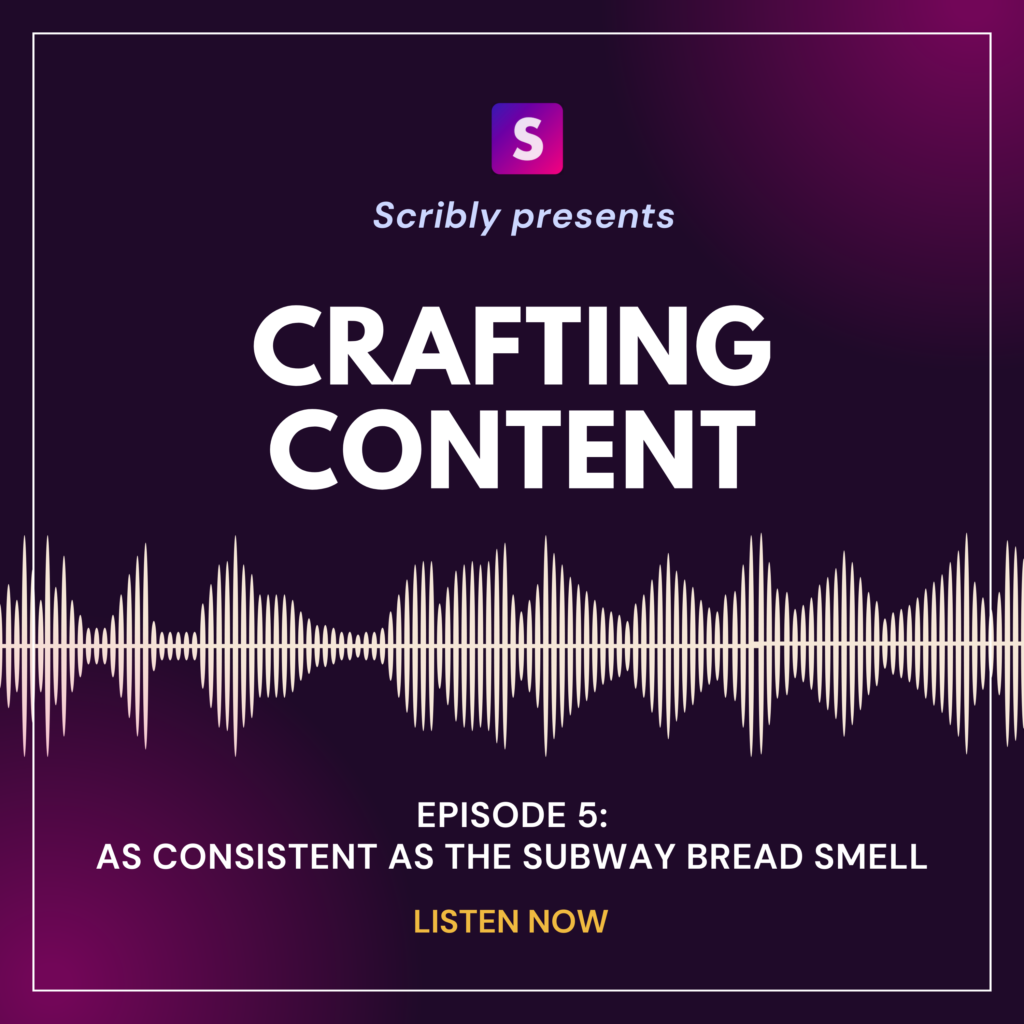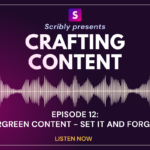Crafting Content – A content marketing podcast from Scribly
Crafting Content Episode 5: As consistent as the Subway bread smell
The fifth episode of Scribly’s “Crafting Content” podcast is here! In this new content marketing podcast, we share insights, top tips, and real-world examples to help you develop your content marketing skills.
Continuing on our “common content marketing mistakes” mini-series, today’s topic is about consistency. We discuss the importance of consistently publishing and promoting high-quality content and remaining consistent in your brand messaging, tone of voice, and visuals to build trust and brand recognizability.

You can listen to the full episode here: Scribly’s Content Marketing Podcast Episode 5: As consistent as the Subway bread smell
Episode 5: As consistent as the Subway bread smell (transcript)
Taylor: Hello, and welcome back to Crafting Content, the Scribly podcast. Hi, I’m Taylor. I’m here again in your headphones to talk about more content marketing mistakes. Joining me again is Elle, and today we’re going to talk about not staying consistent.
That’s a vague mistake because that could mean anything. So, what do we mean by not being consistent with your content marketing?
Elle: I guess not saying consistent, as you say, encompasses lots of different things. When we initially started talking about this issue, we were talking more about regularity in terms of publication. There’s a cross between SEO and content. If you want to build authority within SEO, you need to be publishing content regularly. It gives you the opportunity to talk about new topics, to target new sets of keywords, and to grow your keyword profile. You also want to be producing consistent content in terms of delivering regular engaging content for your audience so that they have fresh things to read and fresh information to enjoy and engage with. So, consistency in terms of regular publication to tick that SEO box, but also consistency of quality for user engagement.
But that’s not to be confused with just churning out content. We talked about that in a previous episode already, but there’s this idea that if you just keep publishing everything all the time, you’re going to get results from that.
Whereas—and we talked about this in the high-quality content episode—when we talk about consistency, we also mean consistency in terms of quality. So, you are producing content that people want to read, and that ticks all of the SEO boxes (optimization, structure, readability).
All of that leads into, yes, having content out there to engage your audience, but also creating recognizable content that people know is yours. And there’s a trust factor that comes from consistency. If one week you’re posting a blog post that is really well-researched and lovely to read, and the next week it’s just a couple of short blocks of text that lack information, no one really knows whether or not they can trust you. You’re not building that authority factor that you want to get out of content.
Taylor: With that example, you put out something that’s really thorough and in-depth one week, and then something that’s short, not that interesting or unique the next. That also is quite confusing to people interacting with your brand because one is a very particular thing, and the other is a very particular thing, and they don’t necessarily align. So, you want to send people the message of who you are and what you have to say, and you want that to stay the same throughout all of your content. To a certain degree, this has to do with the tone of voice that you have for your brand and your brand identity in general. You want to have a unified way that you interact with the public, with your potential customers and current customers. If the content isn’t there regularly, that’s an issue because they can’t interact with you at all. And then, if it’s all over the place, then that’s going to send the wrong message too.
Elle: Consistency doesn’t mean just churning out content. It’s about maintaining regular publication of high-quality content that readers are going to enjoy and that you’re proud to put out there, knowing that that’s going to represent your brand, translate your values, and influence how people perceive your brand.
Taylor: Yeah, exactly. So, say I’m a company, I have an app that I want to market to people. It’s a journaling app. I know I need to create consistent content and publish regularly, but what might that look like? A typical schedule for that kind of business?
Elle: It’s important to have 1) a long-term content strategy and 2) a content calendar. That’s the other thing with consistency—you don’t just think of a blog title like “Right, let’s post this this week” and then the next week “Oh, let’s post this”. It needs to be thought out and strategic. If you’re starting off, you probably want to produce more content to begin with to build that authority, grow your keyword profile, and have content there for people to read so they click through from one blog post to the next. They could then explore other similar content that’s related to that topic. You should have a wealth of things for them to explore, as opposed to clicking on a website’s blog and only having three posts. It’s quite off-putting. I’d say launch with 15 blogs as a good starting point. You want a good, full couple-of-scrolls-worth of content there ready for people to read as soon as your blog goes live. Then, as you’re building out, a couple of articles a week is a good place to start, depending on what capacity you have. And then, as you build that out, you could reduce to one blog a week. But it also comes down to how you want to target your various keywords, how much people are talking about your topic, how much awareness you need to build, and how you’re going to promote those blog articles across your other social channels.
You gave the app example, so I’m hoping that you might have worked on an app-based client before and you have a concrete example you can give us.
Taylor: I don’t, I just made that up. But it depends on, like you say, where you are in your content journey. Do you have quite a mature base of content already that is sitting out there on the internet, working for you and pulling people in? If you do, great! Maybe you can have a less rigorous content calendar.
The other thing that’s important to consider is that we have a lot of clients that come to us, and one element of their content marketing is really developed. They have 3000 blog posts on their website, which is like, wow, great job. Don’t know where you had time to do that, but you did it, good for you. But then they have no presence on social media, say, or they’re not using their social media channels to promote their other content that already exists and is already doing good work for them, or not using their social media channels to engage the audience that they do have there. So, I think that it’s also important to find a balance between different channels and different ways of interacting with people. Because if you’re consistently just posting in one place or one type of content, then you’re also kind of consistently ignoring other potential opportunities to interact with your customers.
Elle: Yes, I guess having consistency not just in terms of how frequently you’re putting content out there, but consistency across all the different marketing channels that you’re using. That comes back to consistency in terms of messaging. So that, yes, you’re publishing different types of content on each of your channels—like promoting a blog post on social media—but the way that you’re talking on social media should be the same way that you’re talking to them on the blog or your website. So, it’s that consistency in terms of tone of voice and branding that makes you recognizable.
Taylor: Yeah, exactly. If you think about major brands that you know, they have a consistent message so that you can recognize them no matter where you see them pop up in the world.
Elle: This isn’t quite for content marketing, but I always think of the Subway smell. Like, as soon as you can smell that smell, you know it’s Subway. The other example that came to mind, and again, not necessarily content marketing, but the last Harry Potter films that they did, they didn’t have anything on the promo banners. They just had the actors, and everyone just knew what it meant.
This is branded imagery, which is another thing that is tangent to content marketing. Visuals are so important on social channels and on your website and to make blog posts more engaging and to break up content. So, you want consistency from that perspective as well, with strong brand colors and consistent imagery—whether you use stock imagery or playful caricature drawings or whatever.
If you think about the Logo game—did you ever play that as a kid? The app where you had to guess the brand based on just the logo—tells you how powerful imagery and consistency are. It makes it so that people just see your logo or brand colors and go, “Oh yeah, I know what brand that is”.
Taylor: Yeah, exactly. Uh, I mean, even fonts can do that as well. If you think about anything written in the Coca-Cola script or you see the Disney D, it’s instantly recognizable. Obviously, those are massive and well-established companies, but it goes to show that if you can find ways to make all of these elements work together and stay consistent with your messaging across them, it can have a massive impact on people.
Elle: Yeah, I mean, even Coca-Cola started somewhere, right?
Taylor: Yeah. So, that is consistency, which is a lot of things. It’s everything all rolled into one. But it is very, very important. We will be back in an attempt to be consistent with our episodes, with another episode soon, talking about all things content marketing and going over some more content marketing mistakes that I’m sure you’ll want to tune in for.
Thank you for listening to Crafting Content, a content marketing podcast from Scribly. You can find more information about what we covered today in our show notes.
Scribly is a content marketing agency that helps you boost traffic, generate sales, and increase your bottom line. With our end-to-end service, we take care of everything from content audits and strategy to content creation and management across websites, blogs, socials, and email. We’re a small but mighty team of experienced strategists and marketers who specialize in content creation. If you want to learn more about how Scribly can help your business, please get in touch. You can find more information and send us a message on our website. We’d love to hear from you!




